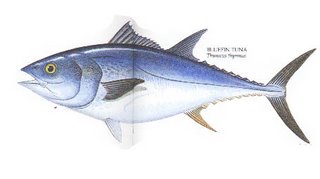


These members of the Scombridae family are widespread in temperate and tropical waters, and have considerable commercial importance as well as being important gamefish. The commercial value of tuna led to them being fished for with enormous driftnets, especially in the Pacific but not here in Malaysia, but use of these nets has been restricted by international agreements because they took a heavy toll not only of tuna but also of unsought-for species including dolphins, sunfish, billfish and Ray's bream.
FISHING NOTES
Techniques
Trolling with lures and drift fishing with natural baits are the usual methods of fishing for tuna, little tunny, and albacore. When fishing for wahoo, try trolling with lures and natural baits. Wahoo are usually taken on flatlines that are fished quite near to the boat, rather than lines on outriggers.
Tackle
For tuna, use a 36.3 to 59 kg (80 to 130 lb) class rod with full roller rings, a level drag multiplier, and 36.3 to 59 kg (80 to 130 lb) nylon line with a 181 to 272 kg (400 to 600 lb) nylon leader. Use hook sizes 10/0 to 12/0, flat for trolling and offset for drifting. For wahoo, use the same class rod with a 6/0 star drag or 30- to 50-class multiplier reel, 13.6 to 22.7 kg (30 to 50 lb) nylon line with a heavy wire leader, and a flat hook size 5/0 to 10/0. However for smaller species, lighter rod is good enough (25 kg) here in Malaysia.
Baits
Use a Kona Head lure when trolling for tuna, koyan pun boleh pakai, and try live mackerel or dead selayang/herring when drifting. When trolling for wahoo, use a Kona Head or other large artificial, or try a natural bait, such as a whole mullet or balao, mounted for trolling. For drift fishing, use a live baitfish on hook sizes 5/0 to 8/0.
Note: Bluefin Tuna & Wahoo
The bluefin tuna is a highly, migratory fish, which is found in subtropical seas during winter and moves into cooler waters in summer. Here in Malaysia, these species are available around the year. Bluefin of up to about 45 kg (100 lb) travel in huge schools, but larger fish form smaller schools and the biggest individuals are often solitary.
The long, slender-bodied wahoo makes tremendous runs with abrupt changes of direction when hooked, sometimes leaping from the water, and this makes it one of the most exciting fish to catch. Its long, heavily toothed jaws form a beaklike snout, and its first dorsal fin is long, low, and spinny. The average weight is about 6.8 to 9 kg (15 to 20 lb), but it can grow up to 83 kg (183 lb) and a length of 2.1 m (6 ft 11 in).
Grouper (Kerapu)
The Serranidae is large and important family of fish, consisting of more than 375 species. These are mostly temperate and tropical marine fish, ranging size from less than 30 cm (12 in) to about 3.7 m (12 ft), and are found near rocks, reef, wrecks, and piers in coastal waters. The larger members of the family are robust, sharp-toothed, basslike fish, which live near the bottom and feed on fish, crustaceans, and shell fish. They tend to be solitary rather than schooling, except at spawning time, and the individuals of many species change sex as they grow: they mature and breed as females, and become males when grow older and larger.
FISHING NOTES
Techniques
Bottom fishing and trolling, using natural or artificial baits, are effective methods for these species. Big species easily found offshore of Terengganu near the oil rigs. Black seabass are also taken from jetties, docks, breakwaters, and piers on saltwater spinning gear and light, general-purpose tackle.
Tackle
For bottom fishing, use a 13.6 to 22.7 kg (30 to 50 lb) class boat rod with a 4/0 to 6/0 multiplier reel and 13.6 to 22.7 kg (30 to 50 lb) mono line; terminal tackle should be a running leger with an 85 to 227 b (3 to 8 oz) pyramid- or bomb-shaped sinker and 2/0 to 6/0 hook. For trolling, try a 36.3 kg (80 lb) class road with a 9/0 multiplier reel, 36.3 kg (80 lb) mono line, a heavy wire leader and 10/0 hook. But trolling on this type of species is not very popular in Malaysia.
Baits
Fish, squid, worms, shrimps, clams, and crab are good baits for bottom fishing. But here mostly of the time they use fillet fish. You can also use natural baits for trolling, as can plugs, spinners, spoons, and feathers especially near rocky reef.
Note: Red Grouper & Jewfish
The red grouper inhabits rocky reefs as depth of 24 to 120 m (80 to 400 ft), but small individuals are sometimes found near the shore in shallow water. This grouper is recognizable by its blotched, reddish coloration, its squared-off tail, and the even top edge of its dorsal fin; the lining of its mouth is orange or deep red. It can attain a weight of 23 kg (50 lb) or more, and fights hard when hooked on light tackle.
This huge grouper (Jewfish) is known to reach a length of 2.4 m (8 ft) and a weight of 310 kg (680 lb), and may grow to 454 kg (1,000 lb) or more. Despite its size, it lives in shallow water - usually not deeper than 30 m (100 ft) - and is found around rocky ledges, wrecks, and pilings. It is not a hard fighter, but its size and weight, and its habit make it difficult to land. The Queensland grouper and Indo-Pacific species, is even even larger and can grow to 3.7 m (12 ft) and over 500 kg (1,100 lb).



















0 comments:
Post a Comment